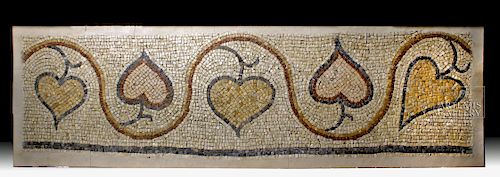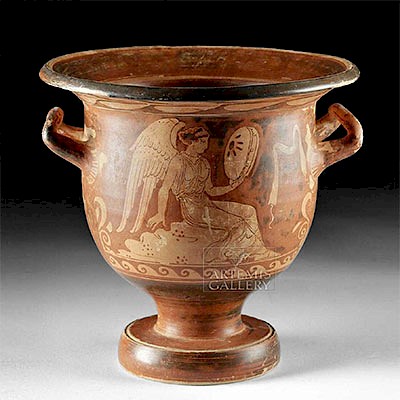Roman Stone Mosaic of Ivy Vine - Heart-Shaped Leaves
Lot 86
About Seller
Artemis Fine Arts
686 S Taylor Ave, Ste 106
Louisville, CO 80027
United States
Selling antiquities, ancient and ethnographic art online since 1993, Artemis Gallery specializes in Classical Antiquities (Egyptian, Greek, Roman, Near Eastern), Asian, Pre-Columbian, African / Tribal / Oceanographic art. Our extensive inventory includes pottery, stone, metal, wood, glass and textil...Read more
Estimate:
$18,000 - $30,000
Absentee vs Live bid
Two ways to bid:
- Leave a max absentee bid and the platform will bid on your behalf up to your maximum bid during the live auction.
- Bid live during the auction and your bids will be submitted real-time to the auctioneer.
Bid Increments
| Price | Bid Increment |
|---|---|
| $0 | $25 |
| $300 | $50 |
| $1,000 | $100 |
| $2,000 | $250 |
| $5,000 | $500 |
| $10,000 | $1,000 |
| $20,000 | $2,500 |
| $50,000 | $5,000 |
| $100,000 | $10,000 |
| $200,000 | $20,000 |
About Auction
By Artemis Fine Arts
Mar 7, 2019
Set Reminder
2019-03-07 10:00:00
2019-03-07 10:00:00
America/New_York
Bidsquare
Bidsquare : VARIETY SALE | Antiquities & Ethnographic Art
https://www.bidsquare.com/auctions/artemis-gallery/variety-sale-antiquities-ethnographic-art-3928
Around the world & back in time - be amazed at the treasures you will find. Antiquities from Egypt, Greece, Italy and the Near East, Asian, Pre-Columbian, African / Tribal / Oceanic, Native American, Spanish Colonial, Russian Icons, Fine Art, much more! Artemis Fine Arts info@artemisfinearts.com
Around the world & back in time - be amazed at the treasures you will find. Antiquities from Egypt, Greece, Italy and the Near East, Asian, Pre-Columbian, African / Tribal / Oceanic, Native American, Spanish Colonial, Russian Icons, Fine Art, much more! Artemis Fine Arts info@artemisfinearts.com
- Lot Description
Roman, the Levant, late Imperial Period, ca. 3rd to 5th century CE. An elegant mosaic presenting a meandering tendril of heart-shaped ivy leaves. The design is comprised of square and triangular stone tesserae in hues of sunny yellow, russet red, and dove grey against a creamy white ground with a linear grey groundline to help focus the eye on the composition. Size: mosaic measures 72.375" W x 19" H (183.8 cm x 48.3 cm); 76.375" W x 22.25" H (194 cm x 56.5 cm) including matrix and metal frame
Mosaics (opus tesellatum) are some of our most enduring images from the Roman world, exciting not only for their aesthetic beauty, but also because they reveal what Romans chose to depict and see every day decorating their private and public spaces. In ancient Rome, ivy was a symbolic of intellectual achievement, and ivy wreaths were used to crown the winners of poetry contests and the like.
In the Roman province of Syria, which encompassed most of the ancient Near East/Levant, mosaics seem to have developed as a common art form relatively late, with most finds coming from the 3rd century CE or later. Syria was one of Rome's wealthiest provinces, but it was also far removed from Rome itself and Roman culture was overlaid on enduring cultural traditions from Hellenistic Greece and the great civilizations that came before it. Antioch-on-the-Orontes (modern day Antakya, Turkey), was the capital of northern Roman Syria, and its excavations in the 1930s revealed more than three hundred mosaic pavements - of which many embellished public baths. Popular mosaic themes from this region were often mythological or religious scenes, depicting gods and goddesses. Ivy was oftentimes associated with Bacchus - god of wine, the grape harvest, and theatricality. In addition, mosaics were created to fit the theme of a building or room. Perhaps, given this association, this piece was intended for a dining room where wine would be enjoyed or a theatre. It is also possible that it was intended for an ancient library given ivy's association with intellectual prowess.
Provenance: private East Coast, USA collection
All items legal to buy/sell under U.S. Statute covering cultural patrimony Code 2600, CHAPTER 14, and are guaranteed to be as described or your money back.
A Certificate of Authenticity will accompany all winning bids.
We ship worldwide and handle all shipping in-house for your convenience.
#139211Expected surface wear with minor losses, nicks, fissures, and abrasions to tesserae commensurate with age. Set in a modern plaster matrix with a metal frame.Condition
- Shipping Info
-
All shipping is handled in-house for your convenience. Your invoice from Artemis Gallery will include shipping calculation instructions. If in doubt, please inquire BEFORE bidding for estimated shipping costs for individual items.
-
- Buyer's Premium



 EUR
EUR CAD
CAD AUD
AUD GBP
GBP MXN
MXN HKD
HKD CNY
CNY MYR
MYR SEK
SEK SGD
SGD CHF
CHF THB
THB
















